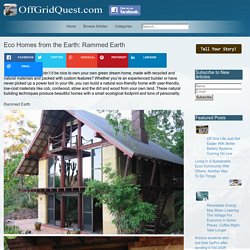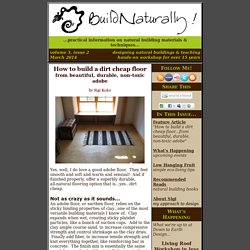

Earth Architecture. Eco Homes from the Earth: Rammed Earth. Wouldn’t it be nice to own your own green dream home, made with recycled and natural materials and packed with custom features?

Whether you’re an experienced builder or have never picked up a power tool in your life, you can build a natural eco-friendly home with user-friendly, low-cost materials like cob, cordwood, straw and the dirt and wood from your own land. These natural building techniques produce beautiful homes with a small ecological footprint and tons of personality. Rammed Earth (images via: rogers rammed earth) Fireproof, termite-proof, storm resistant, extremely low-maintenance and literally dirt-cheap: all of these qualities make rammed earth an attractive natural DIY option for owner-builders.
The dirt is often from the home site, typically packed into a wood wall former, and the results are stunning and well suited for modern home designs. (images via: rammed earth) by Steph / via WebEcoist. Earthen Floors: A Modern Approach to and Ancient Practice [Book Review] Earthen floors are ubiquitous in most of the world.
![Earthen Floors: A Modern Approach to and Ancient Practice [Book Review]](http://cdn.pearltrees.com/s/pic/th/earthen-approach-practice-100570573)
They are the most accessible type of flooring to a vast portion of the human population. In the modern world earthen floors are still something of an oddity to most people, that is until they step foot on one. And then they are hooked for life. As a simple mixture of sand, clay, water and fibers, more and more people are installing them in their new modern homes with stunning results. Today’s practitioners of earthen floors are able to create extremely beautiful, deeply rich wearing surfaces in our most refined spaces. Sukita Crimmel and James Thompson have put together a work of art matched only by the sheer beauty of their floors.
As with any type of flooring, earthen floors have limitations, leading to minor maintenance and occasional major refinishing. Small details from showing you how to protect new door jambs from wheelbarrow damage to dealing with sprouted seeds often found in the clay and sand mixture are included. How to build a durable Adobe Floor. An adobe floor, or earthen floor, relies on the sticky binding properties of clay...one of the most versatile building materials I know of.

Clay expands when wet, creating sticky platelet particles, like a bunch of suction cups. Add to the clay ample course sand, to increase compressive strength and control shrinkage as the clay dries. Finally add fiber, to increase tensile strength and knit everything together, like reinforcing bar in concrete. The finish mix is essentially the same as adobe or cob. And the installation is similar to a concrete slab, only without the environmental impacts or cold nature of cement. A typical adobe floor includes a build-up of layers, each with a purpose. You want your floor to rest on solid ground (or a stiff framed floor with little flex)...movement below translates to cracks up above. Next you install several inches of gravel to provide a capillary break that prevents any potential liquid water in the ground from rising up into the floor. Earthbag Building Index. Clifton’s Rammed Earth Blog » Blog Archive » Amphitheatre walls @ UBC – Building Wall 2. We are now onto building the second rammed earth wall in the UBC botanical garden.

This wall is 55 feet long, curved and fades into the grade. Thanks to Katie who works at the garden for providing a few of the pictures scattered through our posts on the amphitheatre. The footing for wall 2 is ready. The round circle to the right is where the fountain will be going.